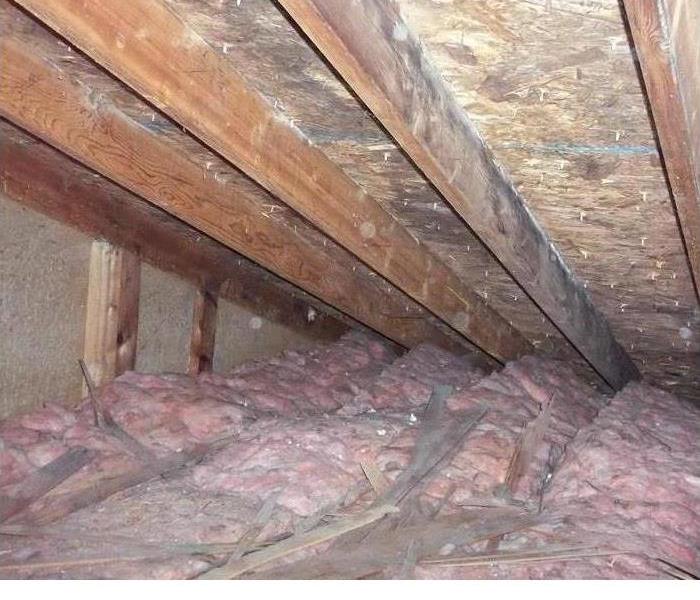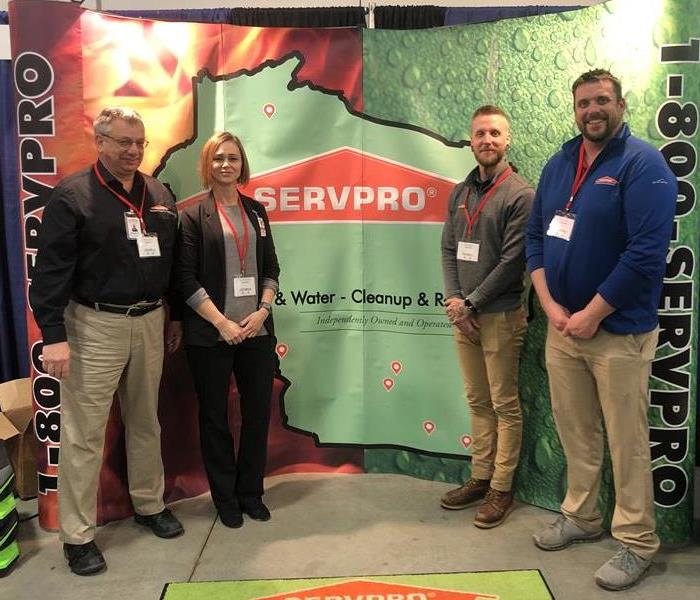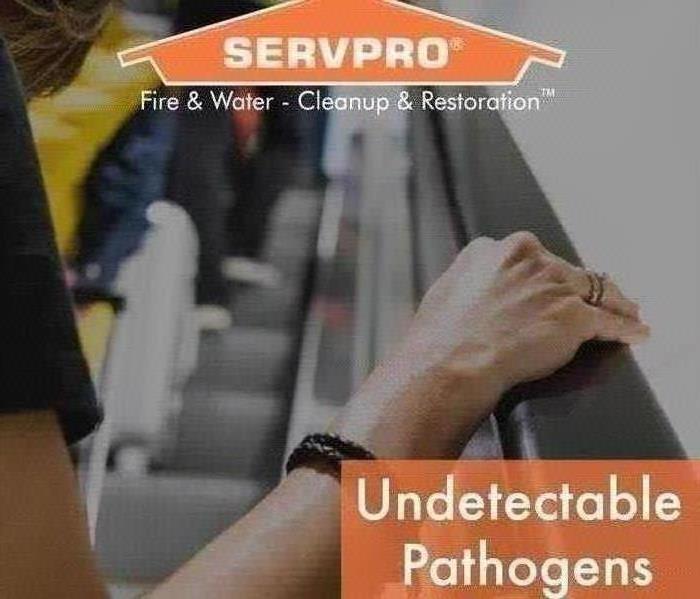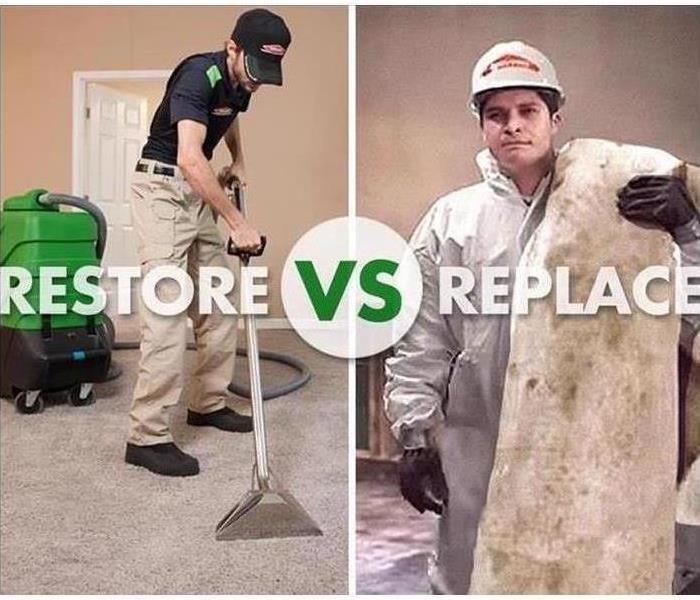Recent Why SERVPRO Posts
Common Plumbing Issues in Commercial Buildings
10/5/2022 (Permalink)
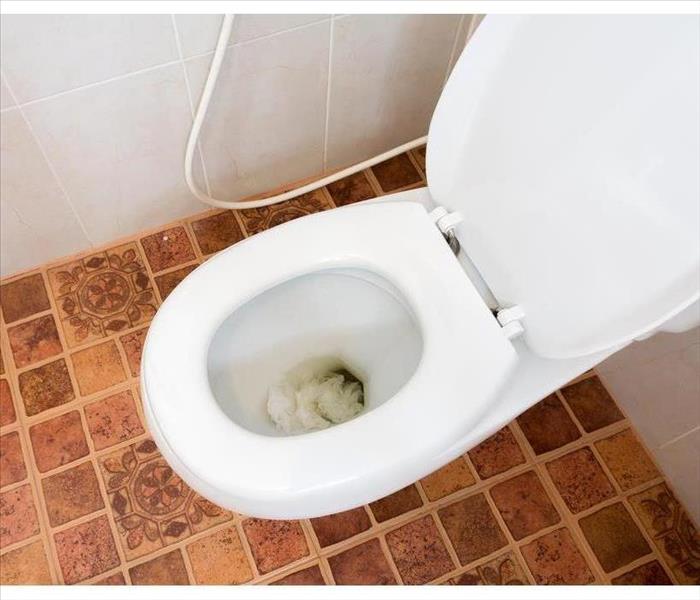 A blocked line can cause many other issues, including toilet overflow.
A blocked line can cause many other issues, including toilet overflow.
Plumbing Problems in Commercial Structures
Whether you rent space or own a commercial building, you need to understand these common plumbing problems. Some, such as a blocked sewer, are relatively easy to deal with, while others, including broken pipes, require considerably more intervention. Here are some typical situations that you might face.
Foundation Shifts and Cracks
Over time, foundations shift and can crack. This can lead to a number of issues:
- Incoming and outgoing pipe breaks
- Outgoing sewage line breaks
- Flooding
- Wall and floor damage
Although all of these are fixable, you can only do it at considerable expense. In some cases, your business insurance might cover these. You will have to check your policy.
Blocked Sewer Lines
Many things can obstruct the sewer lines. Everything from flushing the wrong item down the toilet to a piece of concrete falling into an outgoing line at the street level can contribute to this problem. No matter what precipitates it, you need to quickly take care of it because a blocked line can cause many other issues, including toilet overflow.
Broken Pipes
Like a sewer blockage, broken pipes can be disastrous for a business. A blockage may even cause a pipe to burst. When a pipe breaks, it can cause flooding problems. In the case of severely damaged pipes or flooding, you need to call a water remediation company in Glenwood City, WI. These specialists can quickly and effectively clean your business before the water causes other issues such as mold and mildew.
Deteriorating Lines
Depending on the building's age, you might have copper, concrete or even steel and cast iron lines. All of these are subject to deterioration. As pipes decay, they can seep or leak, causing mold, mildew and other serious problems. Periodic inspection of these lines is necessary to keep them functioning properly.
Take care of a blocked sewer or broken plumbing problem immediately since they can ruin your business and building. Although you can't always prevent them, staying alert can help get these difficulties fixed before they interrupt your normal operations.
How To Clean Black Mold in Commercial Air Ducts
9/5/2022 (Permalink)
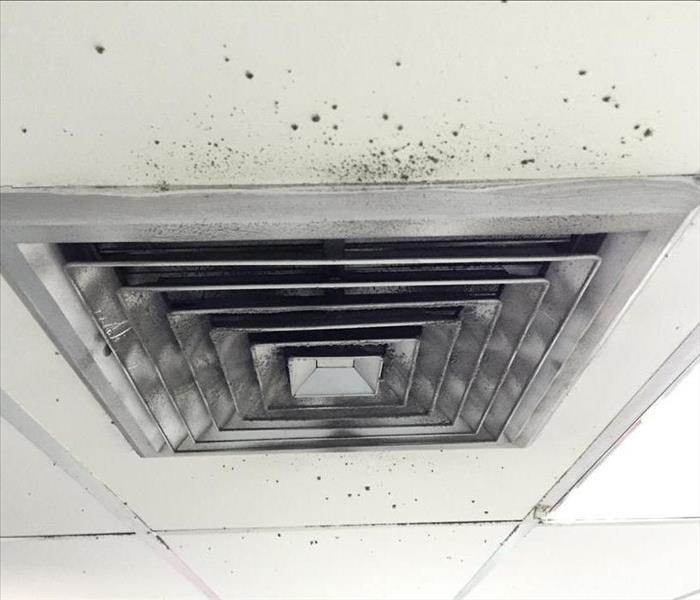 So regular duct maintenance can mitigate this risk.
So regular duct maintenance can mitigate this risk.
Air ducts are a haven for black mold. When is the last time you had your ventilation system professionally cleaned? As a commercial business owner, you know that costly repairs can seemingly come out of thin air. This time, they're coming out of your air vents.
Signs of Mold Overgrowth in Air Ducts
Watch out for these classic signs of vent contamination:
- Black, dusty, hard-to-remove patches around air vents
- The musty smell upon turning on the AC
- Itchy, watery eyes and sneezing
It's always possible that mold overgrowth goes undetected. For this reason, it's best to remain vigilant and keep clean ducts.
How To Clean Ducts
Cleaning an air ventilation system is not an easy task. For this reason, it's best to consult a professional right off the bat. Attempting this feat alone is not only time-consuming, but it could be harmful to you and your clients in the building. If not done properly, attempting to remove black mold may accidentally exacerbate the issue. Luckily, there are some simple steps you can take instead.
Contact an expert in Prescott, WI.
The right mold remediation professionals will verify that mold is indeed present.
Cleaning will begin, and if spread to insulation, insulation will need to be replaced.
The professional team will use the correct cleaners and tools while disinfecting your commercial air ducts.
Once done, now it's your turn: prevent mold regrowth!
How To Prevent Mold Regrowth
Step five is arguably the most important step. Taking the necessary precautions to prevent black mold from reappearing will save you and your commercial business tons of time, money, and stress. In order to stop the fungus from thriving, you need to first locate the source. What is causing the mold to prosper? Air vents are naturally a breeding ground for mold, so regular duct maintenance can mitigate this risk. Make sure the AC filters are changed out periodically. Reduce moisture and humidity in your commercial space. Use natural air circulation when possible, like opening a window. Keep the aforementioned tips in mind, and mold won't have a chance to damage your livelihood.
3 Ways SERVPRO Helps Insurance Adjusters and Their Clients
8/31/2022 (Permalink)
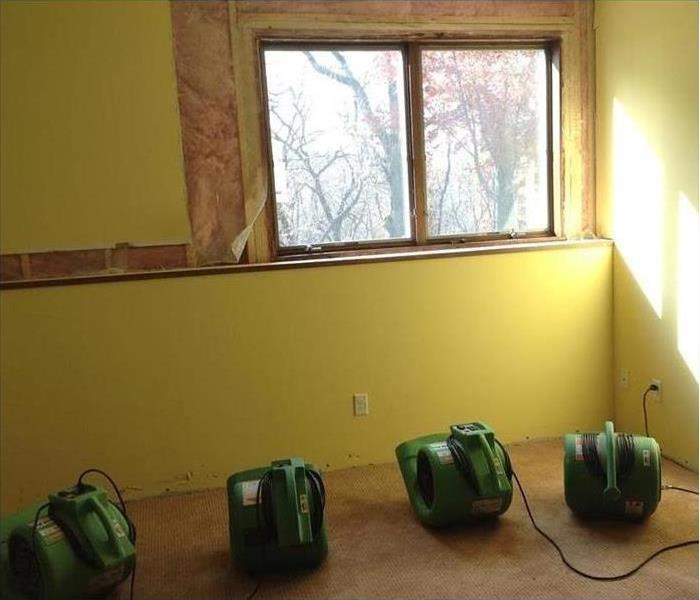 SERVPRO's professionals take pride in their customer service.
SERVPRO's professionals take pride in their customer service.
SERVPRO Offers Three Ways to Assist Insurance Adjusters and Their Clients
The restoration experts at SERVPRO are committed to satisfying their customers. Local and national professionals work as a team to help manage the disaster recovery process, from restoring damaged property to working with an insurance adjuster. While the company's headquarters builds and maintains relationships with insurance companies, it is the local representative that will assist onsite in Prescott, WI. Here are three ways that these experts aid adjusters and their clients.
1. Arrive Quickly To Begin Helping
First, this franchise understands that when an accident or natural disaster damages a business, the owners want and need assistance as soon as possible. The company has over 1,900 locations across the United States and Canada, which enables its restoration professionals to arrive at a disaster site in under four hours. Additionally, this time frame holds day or night because these professionals are available to respond 24 hours a day, every day of the year.
2. Inventory for Information
Once on the scene, professional cleanup workers immediately address emergency issues, such as shutting off water and gas lines. After deeming the site stable, the restoration crew works its way through the property and carefully makes a list of every item, noting the degree of damage. In addition, SERVPRO’s employees will photograph expensive items. These photographs of the inventory will help insurance adjusters determine how much their clients will receive for the losses.
3. Pretest To Reduce Insurance Claim Issues
SERVPRO’s restoration philosophy includes pretesting, which asserts that it is better to restore than replace because repairing damaged goods is usually less expensive than buying new ones. After pretesting, SERVPRO’s local representative can work with the adjuster and its client to save money for everyone involved.
SERVPRO's professionals take pride in their customer service. Helping insurance adjusters make their clients whole again is just one way that these franchises contribute to their communities.
The Top 3 Challenges Posed By Large Losses
8/4/2022 (Permalink)
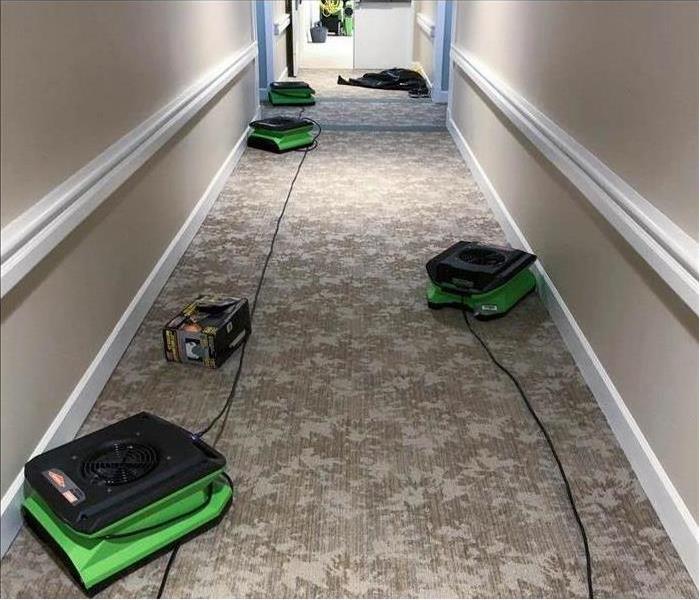 Drying equipment is placed to avoid further damage.
Drying equipment is placed to avoid further damage.
The Top 3 Challenges Posed By Large Losses
A devastating natural disaster such as a tornado or other severe weather events can result in a catastrophic loss of properties throughout Baldwin, WI. Find out more about the three main obstacles property owners and insurance agents must overcome in order to achieve a timely recovery.
1. Many Properties May Be Affected
Adverse weather such as flooding or a tornado can affect an entire neighborhood, town or city. When these events occur, local restoration franchises and independent remediation firms may all have their resources strained to the limit. The difference among these service providers is that franchises in a national company can share staff and resources to meet sudden spikes in demand for mitigation, cleanup and restoration.
2. Insurance Response Can Be Limited
Insurance agents and adjusters in a region affected by severe weather, or any other disaster resulting in catastrophic loss, may also have claims from many clients to inspect. As a result, it may not be possible to visit every affected property before mitigation is needed to limit the severity of the damage. Relying on a restoration company that arrives on-site within hours and thoroughly documents conditions makes it possible to start alleviating the destruction sooner.
3. Property Owners Must Act Quickly
The severity of storm damage can increase significantly over the hours following an incident. It is important to extract water within 24 to 48 hours to prevent serious mold problems. A local restoration franchise that is part of an extensive network can ensure that mitigation and cleanup measures stay on schedule.
Each of these factors has the potential to hold up recovery from an incident that causes catastrophic loss in Baldwin, WI. Property owners and insurers can avoid delays by relying on a restoration company that has over 1,700 locations across North America. Affiliated local and regional franchises can work together to provide mitigation, cleanup and restoration services after a large loss.
3 Ways That SERVPRO Serves Adjusters and Their Clients
5/12/2022 (Permalink)
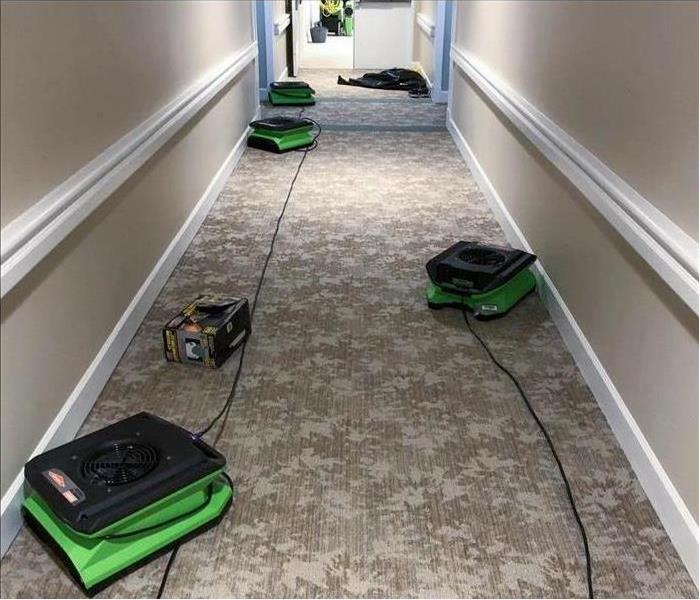 SERVPRO of The Saint Croix Valley offers a response service that is available 24/7.
SERVPRO of The Saint Croix Valley offers a response service that is available 24/7.
SERVPRO Helps Adjusters and Their Clients in Three Ways
An insurance adjuster for business owners in Hammond, WI, collaborates with a variety of professionals to assist clients, including commercial remediation specialists. These companies work with the owners and the adjuster to effectively repair properties after a disaster. However, one of these organizations stands out among the rest. SERVPRO goes above and beyond in serving agents and their clients through various methods.
1. Fast Response
Disasters can occur or manifest at inconvenient times. The insurance client might notice a leak right before the weekend or a fire could ravage a building in the middle of the night. A strong restoration company offers a response service that is available to business owners 24/7 and deploys experts in a matter of hours. Fast emergency repair helps the business recover fast and it reduces the insurance claim expenses, benefitting both the adjuster and the client.
2. Detailed Information
The information regarding commercial damage is important since it helps both the client and the insurance adjuster make the best decision regarding the case. SERVPRO has a claims information center that collects and organizes information in a way that is useful to the insurance agent. It provides a job file that includes photos, detailed descriptions and paperwork, as well as job costs and industry-standard comparisons. Agents can request this information in both physical and electronic copies.
3. Pretesting Process
Adjusters prefer to restore property and objects instead of replacing them, as the latter is more expensive. The best way to measure restorability is to have a remediation company run pretesting on the affected area and belongings. In addition to determining what can be salvaged or replaced, the process provides information to both the technicians and the adjusters. They can see what equipment and methods they need for the best results and the estimated costs of the procedure.
The right remediation company can make the repair process beneficial to both the insurance adjuster and the establishment owner. SERVPRO provides these services and more to successfully help both parties.
Renter’s Insurance and Mold – What You Should Know
1/31/2022 (Permalink)
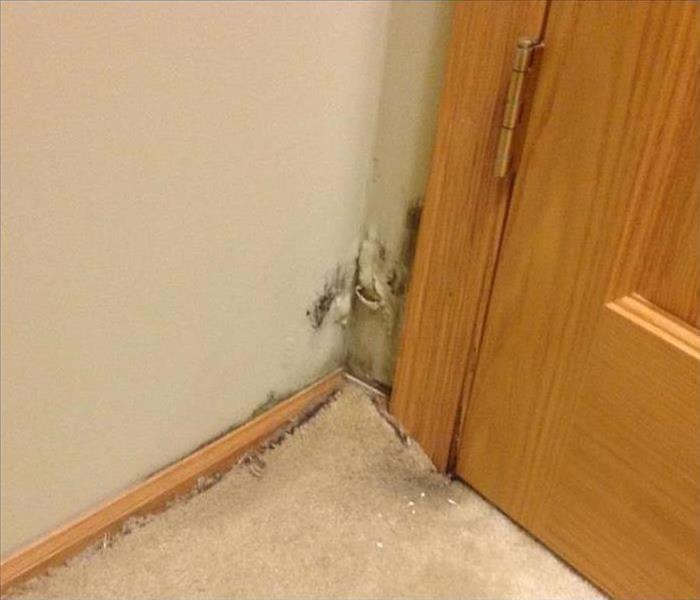 Black mold growth in Hammond, WI.
Black mold growth in Hammond, WI.
Whether you rent or own, hearing that you have mold in your home can be especially stressful. If you’re in an apartment, one of the first things you may wonder is if your rental insurance will cover any damage and removal. This can be a tricky question depending on the policy. Here are a few pointers to help you know when to expect a policy to cover damage to your Hammond, WI apartment, and when you shouldn’t.
What Renter’s Insurance Covers
Many apartment buildings require tenants to carry renter’s insurance as a prerequisite for renting. It’s designed to protect the landlord but also the tenant by covering things like
- Clothing
- Furniture
- Electronics
It can also cover other personal belongings inside an apartment. That’s a broad concept, however, and it can be especially hard to maneuver when it comes to mold.
When Rental Policies Do Cover Mold
Rental insurance does cover damage from mold, but only if it’s the result of a situation that is already covered under the policy. For instance, if your policy covers burse pipes, and one leads to mold damage in your apartment, you should be covered. The same is true for fire, wind, etc. as long as it’s under your policy and is directly related to the mold.
When Rental Policies Don’t Cover Mold
An important exception to mold coverage is related to floods. Many times, renters need separate flood policies. If your policy doesn’t cover flood damage, and mold is a result of floodwaters, you won’t likely get coverage. Also, if mold is a result of your own negligence, you can’t tap into your policy.
Rental insurance can be a huge lifesaver, but only if it covers your particular crisis. Check with your insurance carrier to confirm coverage and call a mold removal specialist to get rid of the mold in your apartment as soon as you spot it.
Do You Suffer from Lawn Slime?
10/12/2021 (Permalink)
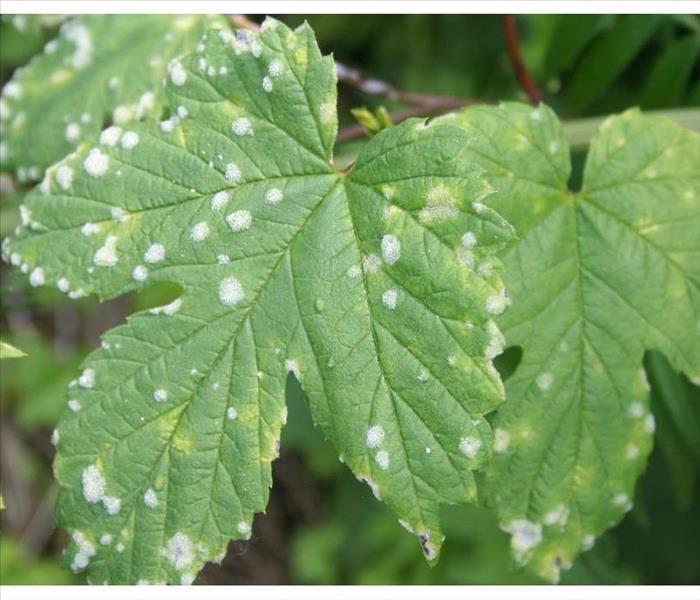 Avoid lawn slime by keeping your lawn clear of debris.
Avoid lawn slime by keeping your lawn clear of debris.
Is Lawn Slime a Problem for You?
Lawn slime is exactly what it sounds like – a creeping, invasive slime that seemingly crops up overnight on your Hudson, WI lawn, often in brightly colored patches. Not only is this slime disgusting, but it can prevent your grass and other cultivated plants from growing. It also poses a safety hazard for slipping on the sticky, gooey mess. But did you know that lawn slime is actually a form of outdoor mold?
Getting to the Root of Lawn Slime
Lawn slime, like any other fungus, feeds on organic matter. Lawn slime in particular prefers dead and decaying matter, and if it’s been a while since you raked the lawn you might have created perfect breeding grounds for lawn slime to grow. Conditions that favor lawn slime include:
- Dark, shaded places, such as beneath thick trees, under bushes, and under heavy leaf, twig, and needle thatch
- Areas with trapped moisture, such as muddy gravel and peat beds or boggy areas
- Accumulations of dead matter such as dead leaves and other rotting foliage
- Hot, humid and/or rainy weather
- Overwatering
- Improper mowing
- Wrong grass type for your yard, leading to dry grass and decaying, dead matter
Keeping Lawn Slime Away
Unlike indoor mold, lawn slime rarely responds to the sort of mold remediation techniques used on household mold. Raking up lawn slime is a start, but as a fungus it often has a network of fibrous matter that extends through places you can’t see. It also doesn’t respond much to chemical treatments or other mold deterrents.
The best offense is a good defense, so avoid lawn slime by keeping your lawn clear of debris, trimming overhanging trees to reduce shadows, and using a sandy soil type that lawn slime has difficulty taking root in. Avoid overwatering your lawn and creating conditions ripe for lawn slime breeding. With a little diligence, you can keep your lawn slime-free.
Spring Cleaning Tips for Homeowners
4/21/2021 (Permalink)
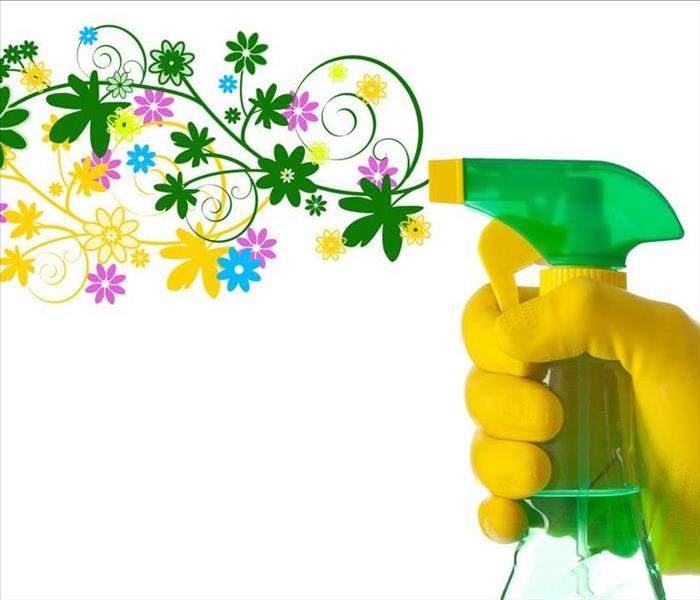 Long days and warmer temperatures make for a great time to do a little spring cleaning.
Long days and warmer temperatures make for a great time to do a little spring cleaning.
Winter has finally started to thaw and the chill in the air is beginning to fade away. Even if you live in a warmer climate with mild winters, springtime brings longer days. Those long days and warmer temperatures make for a great time to do a little spring cleaning.
As a homeowner, your spring-cleaning routine should include a little more than just scrubbing the bathrooms and vacuuming the floors. You can use spring as a time to check up on parts of your home that affect property value and longevity of your house. Our list of spring-cleaning tips for homeowners gives you some ideas for not only cleaning your home but making sure all systems are running correctly.
Remove Dust and Built-Up Dirt
Just like a regular house cleaning, your spring-cleaning routine should include a complete scrub down of your home. You can sweep, vacuum and mop floors to pull up the dust and grime that has built up over winter. Dust along molding and floorboards to pick up the dirt that has settled there. Ceiling fans tend to collect a lot of dust over the winter, so be sure to wipe them down thoroughly using a vacuum attachment or old pillowcase for dusting. Also, be sure to check that the fan is rotating in the correct direction. In spring and summer, you want it to spin counter-clockwise by pressing the switch on the fan’s side. As hot air rises, the counter-clockwise rotation forces cool air down towards the floor.
Do the Laundry
You’ve been doing laundry all winter so you’ll have clean clothes to wear, of course, but spring is a great time to air out warm-weather clothes and linens. Perhaps you use heavier sheets, such as flannel sheets, in the cooler winter months. Use your spring-cleaning day to pull out lighter bedding and wash the winter sheets before storing them until next winter. Alternatively, you might just want to switch up your color palette or décor for the warmer months. Many people switch to a light color scheme for the warmer months. Fresh colored bedcovers such as green, yellow and light blue can help welcome spring into your home.
While you’re doing your laundry, make sure to clean out your washer and dryer and check them for any issues. Be sure that the water lines running to your washing machine aren’t leaking. Give the tub of the washer a good rinse and sweep or vacuum behind and underneath the machine. You will probably also want to do this with your dryer, as well as checking that the vent is properly connected and vents cleanly outside your home.
Check Pipes and Water Lines
An increase in your monthly water or utility bill could be a signal that you have a burst or leaking pipe. Water damage in your home can be a costly expense that is a pain to deal with. Even if you don’t suspect a leak, springtime is a great opportunity to look through your home for any potential leaks or cracks. Check each of your faucets, including the ones outside your home, to make sure that they aren’t dripping. In bathrooms, you should inspect the areas around bathtubs, showers and toilets for leaking or damaged caulking so you can fix it before it becomes an issue.
Service Heating and Cooling Systems
Your heating and cooling units might be some of the most expensive and important equipment in your home. Luckily, these systems tend to have a long life with proper care. Proper maintenance of your heating and cooling systems can save you a lot of money, and a lot of hassle down the road. Spring makes an excellent time to have your heating system checked out after running it all winter. Your air conditioner, likewise, could likely use a checkup from a professional before using it through the hot summer months. You may need to replace things like air filters that have gotten filled with dust and dirt.
Declutter Closets and Storage
Spring cleaning is an ideal time for going through old winter clothes or items and getting rid of things you don’t need. Go through each of the closets or storage spaces in your home and make three piles of the items you find. One will be for keeping, one for donating to charity and one for tossing out in the garbage or recycling. Put your items into their respective piles to help declutter your home. This exercise is also great for making a home inventory list. Home inventory lists are a breakdown of the items in your home that could assist you when filing a homeowners insurance claim. Your list should include important items you would want to be replaced and a short description of each item, including brand and serial number if possible.
Let in Fresh Air While Checking Windows and Doors
One of the best parts of a spring-cleaning day is the chance to let in fresh new air and let out the stuffiness of winter. You can open up all your doors and windows while cleaning to enjoy the sunshine and the springtime breeze. Not only does this make your home feel refreshed, but it also gives you a chance to look at doors and windows for signs of damage or leaks. Be sure to check the caulking around the windows and doors. Sunshine and exposure to the elements can cause caulk to dry out or flake off. Also, check for signs of water damage anywhere around your windows or doors. This might indicate you have a leak from a broken seal.
Clean Gutters
Over the winter, your gutters may have gotten clogged with debris from trees, birds or squirrels. You can either hire a service to clean your gutters for you or you can clean them yourself. If you choose to clean them yourself, remember to be cautious when using a ladder. Always have someone there to help you and hold the ladder for stability.
Check Roofing
A new roof is an incredibly expensive undertaking, so it’s important to keep your current roof in the best shape possible. Check your roof for signs of stress or damage. This might include missing, broken or loose shingles. Additionally, check shingles to make sure they haven’t lost their protective layer. That gritty, asphalt-like substance on a roof tile protects it from the sun’s harmful UV rays. Just like with gutter cleaning, you will want to use caution and have a friend on the ground when you’re up on your roof.
Touch Up Peeling Paint
Peeling or cracking paint on a home never looks good. Even if it’s just cosmetic, peeling paint may lower the overall value and curb appeal of your home. It’s also usually a fairly easy fix. For homes with a lot of peeling paint, or cracked paint in hard-to-reach places, consider hiring a professional contractor to take care of the work for you. If you have a few small spots, you might want to take on the project yourself.
Refresh and Renew Your Home with a Spring Cleaning
A good spring cleaning helps your home feel refreshed and renewed for the warm season. Additionally, spring cleaning gives you the chance to go through your home’s important equipment and systems. You’ll be able to ensure everything is working properly and should be able to feel confident enjoying your home throughout the sunny spring and summer months.
Spring Cleaning Benefits and Tips for the Office
4/19/2021 (Permalink)
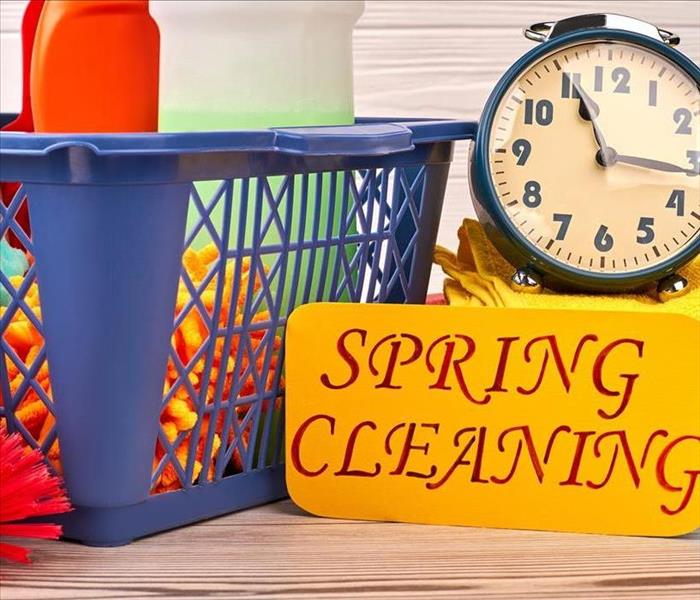 Warm weather is just around the corner and that can only mean one thing—spring cleaning
Warm weather is just around the corner and that can only mean one thing—spring cleaning
Warm weather is just around the corner and that can only mean one thing—spring cleaning. No more dreary weather, muddy footprints, and soaked carpets. Spring is almost here and that means we get to welcome a fresh start.
Now is the perfect time to stow away your winter-related items, declutter unnecessary items, reorganize, and refresh the office. We encourage you to make the most of the upcoming season by reading the rest of our blog post which contains the benefits of office spring cleaning and tips on where to begin.
Cleaning is always a good idea—especially now—as we continue to live with the pandemic along with practicing better hygiene. Five benefits that can stem from spring cleaning your office include:
Reduced stress
Increased productivity
Positive mood
Allergy symptom relief
A more healthy lifestyle
Reduced Stress
Cleaning can help reduce stress because it offers a sense of accomplishment and also makes for a very relaxing experience. Digging through piles of papers and other office materials can be extremely time-consuming and stressful if you cannot find what you are looking for. By cleaning out your office space, you’ll spend less time worrying and stressing about where specific items are.
Increased Productivity
It should come as no surprise that a clean workspace helps to increase productivity. Having pens, papers, staplers, and other office supplies scattered around your desk can be distracting you from your priorities. By cleaning, tossing away unnecessary clutter, organizing, and placing your items back where they belong, not only will your workspace look more presentable, but you’ll also improve your workflow efficiency.
Positive Mood
Clutter is often linked with negative emotions such as irritability and confusion, whereas a clean workspace is linked with positive emotions such as calmness and contentment. A clean environment will help to elevate your mood as it gives you better control of your surroundings. Not to mention, you’ll feel a sense of accomplishment once your workspace is neat and tidy.
Allergy Symptom Relief
Aside from cleaning, the springtime is also unfortunately known for being allergy season. If you have employees who suffer from seasonal allergies, we recommend putting together a regular cleaning and disinfecting routine in order to get rid of immune system triggers such as dust and pollen. We also recommend checking your office’s ventilation system to ensure good indoor air quality.
A more healthy lifestyle
All of the benefits above can be combined to support an overall healthier lifestyle physically, mentally, and emotionally. Spring is the season for new beginnings so get started by cleaning out your workspace today. Not sure where to start? Read our tips below!
Spring Cleaning Tips
Clean and disinfect all surfaces, especially the ones you are in daily contact with such as your desk, keyboard, door handles, etc.
Declutter and organize your drawers, placing everything back where they belong and tossing away unnecessary items
Keep only your frequently used items on your desk and store the rest
Manage long, messy wires or cables by using Velcro strips for a neat and professional look
Perform a digital declutter by getting rid of files and emails that you no longer need and organizing the icons on your desktop to make them more easily accessible
Check in with the appropriate manager regarding the office ventilation system
Make cleaning and disinfecting a part of your weekly routine if possible—if not, consider hiring a commercial cleaning company to come in once a week or as needed.
6 Ways to Save on Electric Bills
4/16/2021 (Permalink)
 When you’re looking for ways to save money, lowering your bills should be a top priority.
When you’re looking for ways to save money, lowering your bills should be a top priority.
When you’re looking for ways to save money, lowering your bills should be a top priority. Some bills are easy to lower, such as that premium cable subscription you never use. Others might seem impossible to cut down.
If you’re like a lot of people, you’d love to lower your electric bill, but you’re not sure where to start. The good news is there are a lot of little changes you can make to help cut energy costs. Start by trying these six simple tips to lower your electric bill.
- Program Your Heating and Cooling
There are a lot of fancy smart-home devices available today, and they can get pretty expensive. Luckily, you don’t need to spend a fortune to add a few smart elements that can help cut your power bills.
Start with a programmable thermostat. You can opt for a top-of-the-line smart thermostat or a simple programmable one. Some smart thermostats allow you to change your home’s temperature from your smartphone remotely. Even a simple programmable thermostat lets you set the temperature in your home for specific times of the day.
Programming your heating and cooling saves you money on electricity by maximizing efficiency when you need it most. In the summer, you could set the thermostat to start running the air conditioning about an hour before you get home from work in the evening. You’ll come home to a cool house while not wasting money cooling the house when no one’s home.
- Unplug Appliances When Not in Use
It’s not always easy to tell if an appliance or gadget is using electricity when it’s turned off, but a lot of them do. Even if you hit the “off” button, leaving an appliance plugged in could be costing you money.
You can cut this unnecessary expense by unplugging appliances when you’re done with them. After making breakfast, unplug the toaster so it doesn’t sap energy till the next morning. You can do the same with almost any appliance or tool in your home — from gaming consoles and televisions to coffee makers and microwaves.
Unplugging all of your appliances after each use might seem inconvenient. Once you’re in the habit, however, you’ll enjoy a lower electric bill while also reducing your chance of overloading an outlet and causing a home fire.
- Wash Your Clothes in Cold Water
Traditional clothes-washing wisdom might tell you to use hot water to get your clothes clean. That’s because laundry detergents of the past needed the heat from hot water to activate. Most modern detergents, however, can work just as well in cold water as hot.
This is good news for your wallet since heating the water for a load of laundry uses a lot of energy. By washing clothes in cold water, you’re reducing the amount of electricity you need.
As a bonus, you’ll also get more use out of your clothes. Cold water is generally less harsh on your clothing than hot water. Hot water can cause fibers to break down and lead to shrinking, running dyes, or faded colors.
Make your laundry even more energy-efficient by skipping a cycle in the hot dryer. You can line-dry your clothes for similar benefits — you’ll save money on energy costs and your clothes won’t be exposed to extreme heat.
- Wear the Right Clothing
It may sound silly but wearing the right clothes indoors can help reduce your heating and cooling costs, ultimately lowering your electric bill.
In the winter, you might be tempted to crank the heater and start a cozy fire in the fireplace. After a while, you realize you’re warm. Instead of turning down the heat or putting out the fire, you change into shorts and a tank top to beat the heat.
In the summer, you could end up doing the opposite. You run the air conditioner so the house is cold, then pull on a sweatshirt or long pants because you’re chilly.
Most of the time, you probably don’t realize you’re changing to match your current comfort level. The next time you reach for an extra layer or change into summer clothes in the winter, try adjusting your home’s thermostat instead.
- Maintain Your HVAC System
Your heating and cooling system has to work hard to give you an ideal indoor temperature, especially if the outdoor temperature is extreme. The best way to keep your HVAC system from running up your electric bill is to practice proper maintenance.
The easiest step is to replace your air filter regularly. The air filter works to keep debris, dust, and allergens out of the air in your home. As the particles collect in the filter, the system has to work harder to move air through. Check your air filter regularly. If it’s dirty and dusty, it’s time to replace it.
You should also consider hiring a professional HVAC technician to service your system each year. A professional will have the tools and knowledge to alert you if there are any issues and clean your system so it’s running properly.
- Keep Your Appliances in Good Condition
A dirty appliance in need of repairs often costs a lot more to run than a clean one. Reduce your energy costs by keeping your appliances in good repair. If you notice an appliance isn’t running as efficiently, such as a dryer not drying clothes, clean out dust, dirt, and buildup or contact a repair company.
When your appliance gets beyond repair, you might want to think about replacing it with a newer, more efficient model. Many modern appliances are designed to reduce energy costs and may even come with a rebate from your local power company.
Reducing your energy expenses can be easy is you follow these six steps. Remember to monitor your monthly bill to see the impact these costing-saving ideas can have on your electric bill.
8 Spring Home Maintenance Projects You Should Do This Season
4/6/2021 (Permalink)
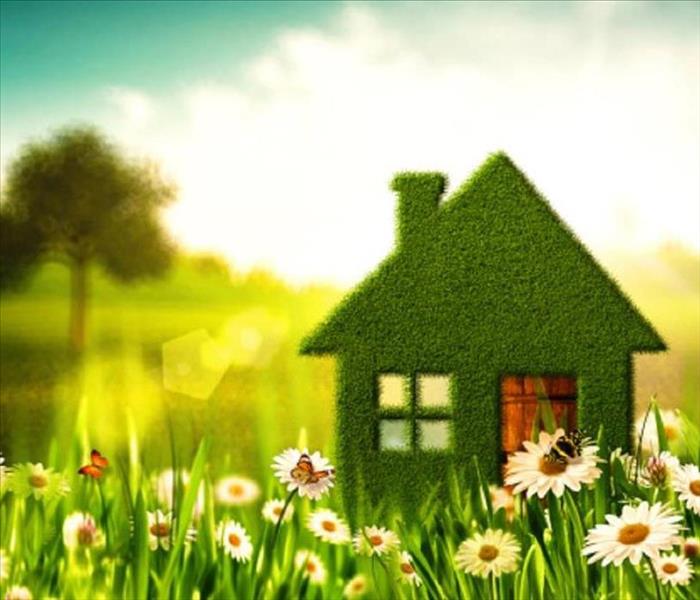 Spring brings longer days and warmer weather, both of which make it easier for us to plan and take on important spring home maintenance tasks.
Spring brings longer days and warmer weather, both of which make it easier for us to plan and take on important spring home maintenance tasks.
Spring brings longer days and warmer weather, both of which make it easier for us to plan and take on important spring home maintenance tasks. From repairing property damage to preparing for summer, there are a number of things that we should do to “tune up” a home’s major systems and features. Doing so doesn’t just maintain your home’s property value – it also helps to prevent bigger breakdowns and repairs down the line.
Not sure where to start? These 8 basic maintenance needs are each worth your attention this month:
Get Your HVAC Inspected
If there is one system you always want to be functional, it’s your heating, ventilation, and air conditioning system. All too often, people skip spring maintenance only to find their system breaking down during the hot summer. Rather than losing the comforts of home during a heat wave, you should hire a licensed professional to service the equipment before the start of summer. Just be sure to discuss any health and safety measures needed during your appointment this spring.
Clean Your Dryer Vent
One of the biggest fire hazards in your home is a clogged dryer vent. Fortunately, you can prevent this hazard by cleaning out your dryer vents each spring.
Check Your Windows’ Caulking
Caulk, the material used to seal the seams around your windows both inside and outside your home, doesn’t last forever, and its breakdown leads to air drafts and water leaks. It’s important to check the caulking in your home every spring for tears, cracks, or gaps. Should you find damaged caulking, it will need to be replaced, either by you or a professional.
Inspect Your Home’s Woodwork
Because it’s exposed to the elements, exterior woodwork requires lots of maintenance. Each spring, you should inspect the state of your wood decks, fences, railings, trellises, pergolas, and other outdoor structures.
In addition to planning necessary repairs and addressing wood rot, you should also plan on staining or resealing these structures every year or two. During your inspection, you should also check for signs of termites, as these insects need to be addressed by pest control sooner rather than later.
Examine Your Roof
Roof maintenance is one of the most important parts of home ownership. Are the shingles in place? Are the vent pipes, flashing, or anything else damaged? Answering these questions annually can help you spot small issues before they become big ones. If you notice anything that needs closer inspection or repair, the next step is to call a roofer, who can work with you to safely determine your next steps.
Clean Your Gutters
While not exactly a favorite chore around the house, cleaning your home’s gutters is extremely important. Blocked or damaged gutters can’t do their job during those numerous spring rain showers. Clogged gutters can also lead to wood rot, pest infestations, and other problems. So debris needs to be removed from gutters each spring, and you should also check that downspouts are still turned away from your home. Additionally, make sure water isn’t collecting at the foundation of your home.
Pressure Wash Your House
Rain, leaves, dust, and other outdoor elements tend to create a buildup of residue on your home’s exterior. In the worst cases, this buildup can lead to green mold! So it’s best to pressure wash the outside of your house each spring to prevent this. At the very least, the annual wash will add shine to your property!
Check Your Basement
In addition to examining exterior elements and essential household systems, you should also examine the state of your basement each spring. Because moisture is a common problem in basements, these are easy places for mold and other types of fungus to grow. To prevent a serious problem from developing, you should examine your basement each spring for signs of moisture or water damage.
These home maintenance projects each play an important part in keeping your home in good condition. Not only will they help you live comfortably and safely – but they’ll also be important should you look to sell your house at some point. So be sure to schedule time to complete each maintenance item this spring.
Be Prepared to Stay Safe and Healthy in Winter
3/16/2021 (Permalink)
 Winter storms and cold temperatures can be dangerous.
Winter storms and cold temperatures can be dangerous.
Winter storms and cold temperatures can be dangerous. Stay safe and healthy by planning ahead. Prepare your home and vehicles. Prepare for power outages and outdoor activity. Check on older adults.
Although winter comes as no surprise, many of us may not be ready for its arrival. If you are prepared for the hazards of winter, you are more likely to stay safe and healthy when temperatures start to fall.
Prepare Your Home
Staying inside is no guarantee of safety. Take these steps to keep your home safe and warm during the winter months.
- Winterize your home.
- Install weather stripping, insulation, and storm windows.
- Insulate water lines that run along exterior walls.
- Clean out gutters and repair roof leaks.
- Check your heating systems.
- Have your heating system serviced professionally to make sure that it is clean, working properly, and ventilated to the outside.
- Inspect and clean fireplaces and chimneys.
- Have a safe alternate heating source and alternate fuels available.
- If you do not have a working smoke detector, install one. Test batteries monthly and replace them twice a year.
- Prevent carbon monoxide (CO) poisoning emergencies.
- Install a CO detector to alert you of the presence of the deadly, odorless, colorless gas. Check or change the battery when you change your clocks in the fall and spring.
- Learn the symptoms of CO poisoning: headache, dizziness, weakness, upset stomach, vomiting, chest pain, and confusion.
Get your vehicle ready for cold weather use before winter arrives.
Prepare Your Vehicle
Get your vehicle ready for cold weather use before winter arrives.
- Service the radiator and maintain antifreeze level.
- Check your tires’ tread or, if necessary, replace tires with all-weather or snow tires.
- Keep the gas tank full to avoid ice in the tank and fuel lines.
- Use a wintertime formula in your windshield washer.
- Prepare a winter emergency kit to keep in your car in case you become stranded. The kit should include:
- Cell phone, portable charger, and extra batteries;
- Items to stay warm, such as extra hats, coats, mittens, blankets, or sleeping bags;
- Food and water;
- Booster cables, flares, tire pump, and a bag of sand or cat litter (for traction);
- Compass and maps;
- Flashlight, battery-powered radio, and extra batteries;
- First-aid kit; and
- Plastic bags (for sanitation).
Prepare for Emergencies
Be prepared for weather-related emergencies, including power outages.
- Stock food that needs no cooking or refrigeration and water stored in clean containers.
- Ensure that your cell phone is fully charged.
- When planning travel, be aware of current and forecast weather conditions.
- Keep an up-to-date emergency kit, including:
- Battery-operated devices, such as a flashlight, a National Oceanic and Atmospheric Administration (NOAA) Weather Radio, and lamps;
- Extra batteries;
- First-aid kit and extra medicine;
- Baby items; and
- Cat litter or sand for icy walkways.
- Protect your family from carbon monoxide (CO).
- Keep grills, camp stoves, and generators out of the house, basement and garage.
- Locate generators at least 20 feet from the house.
- Leave your home immediately if the CO detector sounds, and call 911.
Wear appropriate outdoor clothing: layers of light, warm clothing; windproof coat, mittens; hats; scarves; and waterproof boots.
Take Precautions Outdoors
Outdoor activities can expose you to several safety hazards, but you can take these steps to prepare for them:
- Wear appropriate outdoor clothing: wear a tightly woven, preferably wind-resistant coat or jacket; inner layers of light, warm clothing; mittens; hats; scarves; and waterproof boots.
- Sprinkle cat litter or sand on icy patches.
- Learn safety precautions to follow when outdoors.
- Work slowly when doing outside chores.
- Take a buddy and an emergency kit when you are participating in outdoor recreation.
- Carry a cell phone.
Do This When You Plan to Travel
When planning travel, be aware of current and forecast weather conditions.
- Avoid traveling when the National Weather Service has issued advisories.
- If you must travel, inform a friend or relative of your proposed route and expected time of arrival.
- Follow these safety rules if you become stranded in your vehicle.
- Make your vehicle visible to rescuers. Tie a brightly colored cloth to the antenna, raise the hood (if it is not snowing), and turn on the inside overhead lights (when your engine is running).
- Move anything you need from the trunk into the passenger area. Stay with your vehicle unless safety is no more than 100 yards away.
- Keep your body warm. Wrap your entire body, including your head, in extra clothing, blankets, or newspapers. Huddle with other people if you can.
- Stay awake and stay moving. You will be less vulnerable to cold-related health problems. As you sit, keep moving your arms and legs to improve circulation and stay warmer.
- Run the motor (and heater) for about 10 minutes per hour, opening one window slightly to let in air. Make sure that snow is not blocking the exhaust pipe—this will reduce the risk of carbon monoxide (CO) poisoning.
Be ready to check on family and neighbors who are especially at risk from cold weather hazards: young children, older adults, and the chronically ill.
If you have pets, bring them inside. If you cannot bring them inside, provide adequate, warm shelter and unfrozen water to drink.
No one can stop the onset of winter. However, if you follow these suggestions, you will be ready for it when it comes.
Please follow our page, as we continue to explore the benefits of mitigation, and how this approach helps both your clients and your business. Please call us with any questions you have, 715-381-2266. Visit our site: SERVPRO of The Saint Croix Valley
SERVPRO is Here to Help During This Time of Need
3/12/2021 (Permalink)
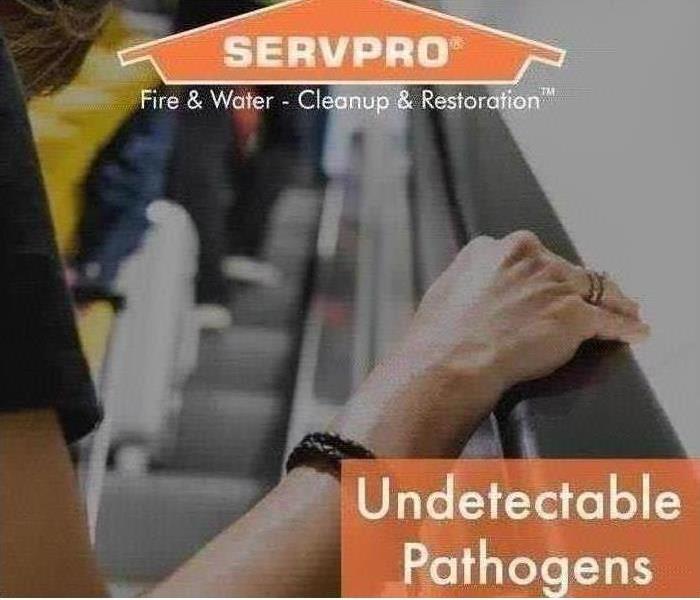 We are prepared to clean and disinfect your home or business.
We are prepared to clean and disinfect your home or business.
During this unprecedented time caused by the global pandemic of corona virus, this is a reminder to our customers that we are specialists in cleaning services, and we adhere to the highest cleaning and sanitation standards.
Specialized Training
We are prepared to clean and disinfect your home or business, according to protocols set forth by the Centers for Disease Control and Prevention. We have years of experience in dealing with biological contaminants, and we will go beyond the scope of work that regular janitorial staff perform on a daily basis.
The CDC encourages cleaning of high-touch surfaces such as counters, tabletops, doorknobs, light switches, bathroom fixtures, toilets, phones, keyboards, tablets and tables. Other spaces mentioned in the CDC’s guidance for commercial spaces include:
- Kitchen/Food Areas
- Bathrooms
- Schools/Classrooms
- Offices
- Retail Spaces
- Water Fountains
- Shelving/Racks
- Sales Counters
- Carpets and Rugs
- Stair Handrails
- Elevator Cars
- Playground Equipment
- Fitness Equipment
Specialized Products
The CDC recommends usage of a labeled hospital-grade disinfectant with claims against similar pathogens to the corona virus. Multiple products in the SERVPRO product line carry the EPA-approved emerging pathogens claims. While there is currently no product tested against this particular strain of the corona virus, we are following all guidelines as provided by the CDC and local authorities.
It’s National Preparedness Month: Make a plan
9/4/2020 (Permalink)
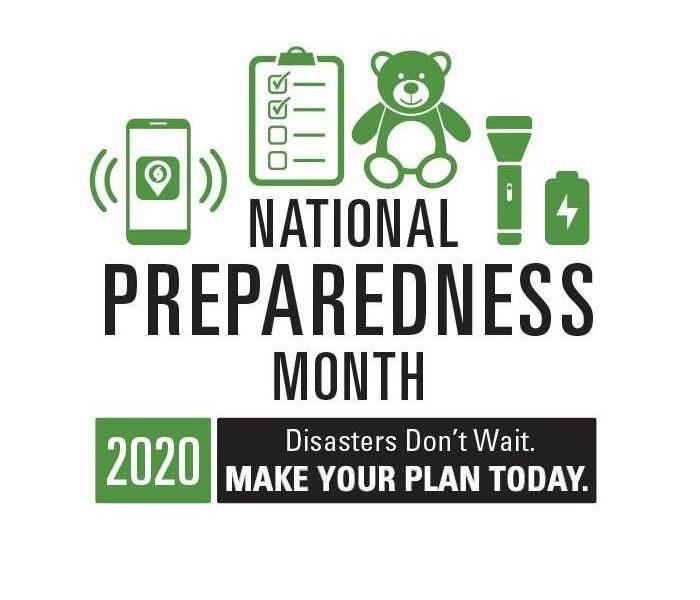 Extreme weather and natural disasters can occur with little warning.
Extreme weather and natural disasters can occur with little warning.
Extreme weather and natural disasters can occur with little warning. This year’s floods and wildfires are proof of that. Are you ready to leave your home at a moment’s notice? You can reduce your anxiety about these scary events by making sure you are prepared if and when they happen. September is National Preparedness Month and a good time to get your family, pets, and property ready. You can, for example:
- Organize your finances. When it comes to preparing for situations like weather emergencies, financial readiness is as important as a flashlight with fully charged batteries. Having your financial documents up-to-date, in one place, and portable can make a big difference at a tense time.
- Replace missing documents. If you’re missing important documents, now’s the time to replace them.
- Check your insurance. Find out if any of your home, health, or other insurance policies will pay for temporary shelter, replacement clothing, furniture, or other items if you are affected by extreme weather or a disaster.
- Prepare your home. From floods to fires, earthquakes, high winds and tornadoes, check out The Federal Emergency Management Agency’s (FEMA) How-To Series: Protect Your Home or Business. If you live where storms and flooding are likely, visit floodsmart.gov to learn about FEMA’s National Flood Insurance Program.
- Plan for your pets. If you’re like millions of animal owners nationwide, your pet is an important member of your household. A little planning today can help ensure safety for your pets during an emergency.
- Sign up for alerts and warnings in your area. Public safety officials use timely and reliable systems to alert you and your family in the event of severe weather and disasters.
Please follow our page, as we continue to explore the benefits of mitigation, and how this approach helps both your clients and your business. Please call us with any questions you have, 715-381-2266. Visit our site: SERVPRO of The Saint Croix Valley https://www.SERVPROthesaintcroixvalley.com/
6 Steps to a Professional Kitchen Hood Cleaning
9/1/2020 (Permalink)
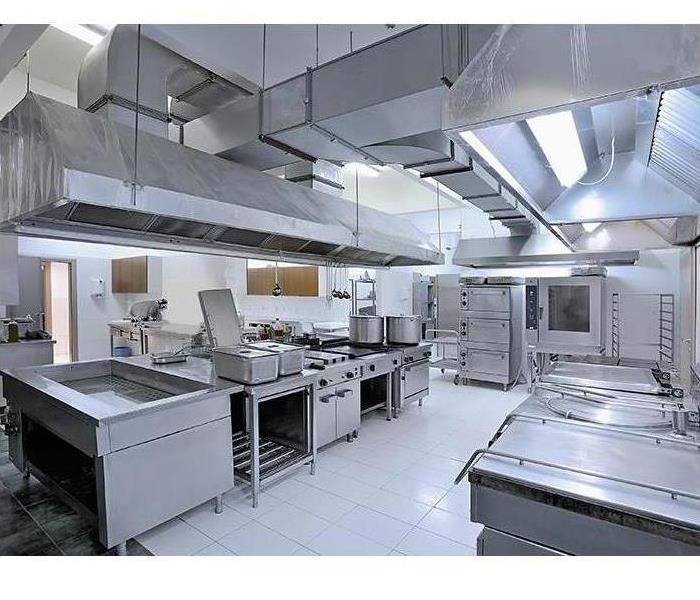 Regular cleanings of restaurant kitchen hood vents are an essential part of any fire safety maintenance plan.
Regular cleanings of restaurant kitchen hood vents are an essential part of any fire safety maintenance plan.
Regular cleanings of restaurant kitchen hood vents are an essential part of any fire safety maintenance plan. Without regular attention, oil and other debris can build up in the hood, exhaust fan, filters and ductwork, significantly increasing the chances of a grease fire. Undergoing a hood cleaning twice a year will help you meet the National Fire Protection Agency’s (NFPA) standards for reducing the risk of fire. This process typically takes between three and six hours. To help you prepare for your upcoming appointment, here’s a guide to what to expect during this procedure.
What Happens During a Professional Hood Cleaning?
- Kitchen Prep
Hood cleaning may create a mess, so the cleaning company will begin by prepping the kitchen for the process. This includes turning off pilot lights and gas valves, covering appliances, and removing any items that could potentially get contaminated by the cleaning chemicals and dirty water. The cleaning crew will also remove all filters and disassemble any wall-mounted hoods and fans for cleaning.
- Filter Cleaning
Kitchen exhaust filters often become caked in grease and grime. The hood cleaning process involves removing the filters and soaking them in a cleaning solution to loosen the hardened grease. After several hours, the filters are power-washed and then reinstalled.
- Fan Cleaning
Kitchen exhaust fans are another place where grease builds up. Fire safety maintenance requires the fans to be removed for a thorough cleaning from top to bottom to reduce hidden hazards. The crew will spray the fan with degreasing chemicals and then scrub the blades clean by hand and power washing. Before the fans are reinstalled, the entire system is inspected and the fan belts replaced to ensure it’s in working order.
- Vent & Ductwork Inspection
NFPA guidelines require that all exhaust duct systems be cleaned and degreased regularly, so a thorough hood cleaning includes manually scraping any solidified grease from the vents and ducts before spraying on chemicals to dissolve the remaining grease. After a final scrub, the vents and ductwork are inspected to ensure they comply with NFPA rules.
- Power Washing
Once the fans, vents, and filters are clean, the crew will tackle the kitchen hoods themselves. This begins with manually scraping congealed grease from the hood, and then applying a degreasing cleaning chemical to loosen any remaining residue. After 30 to 60 minutes, the cleaners’ power-wash the hood with hot water, leaving it clean and free of grease that could start a fire.
- Inspection & Documentation
The final step of the process happens once the crew has restored the kitchen to its prior condition. This is when the process will be documented and your technician will apply a certification sticker to the unit. This tells health inspectors and insurance companies that you are in compliance NFPA guidelines and have worked with licensed fire protection services to ensure the safety of your kitchen.
Facts About Mold
9/1/2020 (Permalink)
 For more than a decade, mold has been in the news.
For more than a decade, mold has been in the news.
For more than a decade, mold has been in the news. People are talking about the effect on population health and damage to the building. But what are the risks and issues?
The term “mold” is a colloquial term for a group of filamentous fungi that are common on food or wet materials. This includes the green Penicillium species that produces penicillin, and fungi that spoil our bread, fruit, cheese and crops. Most of these are Ascomycetes that produce a lot of spores.
The majority of the molds that grow on damp building materials are found in the soil and are adapted to grow on a wide variety of materials. Outdoors, molds live in the soil, on plants, and on dead or decaying matter. There are thousands of species of mold and they can be any color. Different mold species are adapted to different moisture conditions ranging from very wet to just damp. Many times, mold can be detected by a musty odor. Live spores act like seeds, forming new mold growths (colonies) under the right conditions. All of us are exposed to a variety of fungal spores daily in the air we breathe, both outdoors and indoors.
How mold gets into a house or building
Mold and fungal spores occur naturally outdoors, where fungi are the earth’s most important recyclers. Indoors, mold needs moisture to grow; it becomes a problem only where there is water damage, elevated and prolonged humidity, or dampness. Common sources of excessive indoor moisture that can lead to mold problems include:
- flooding from surface waters (i.e., overflowing rivers) or from severe storms;
- roof leaks from damaged or missing roofing materials, ice dams or blocked gutters;
- storm-driven rain through window frames, exterior walls or door assemblies;
- leaking pipes, sewer back-ups or overflows;
- damp basements or crawl spaces due to a high-water table or poorly managed rainwater drainage; and
- condensation on cold surfaces.
How to prevent mold growth
The key to preventing and stopping indoor mold growth is to control excessive moisture and condensation. Keeping susceptible areas in the home clean and dry is critical. In general, mold will not grow indoors without water, dampness or excessive moisture.
Three main factors contribute to condensation of water on building surfaces:
- Relative Humidity: Condensation occurs when the air is saturated with water and it cannot hold any more moisture. For example, steam generated from bathroom showers or from cooking can fill up the air with moisture, which will then condense into drops of water on cooler surfaces, such as mirrors and windows. Where possible, localized sources of humidity, such as clothes dryers, should be directly vented to the outdoors. To lower indoor humidity during warm, humid weather, air conditioners and/or dehumidifiers should be used. In chronically damp areas such as basements or crawlspaces, it is often recommended that dehumidifiers be used to maintain humidity levels below 60 percent.
- Temperature: Warm air holds more moisture than cold air. Condensation occurs when warm humid air comes into contact with a cold surface and the moisture condenses into water. This can often be seen on single-pane windows, where water condenses and then runs down, causing the wood frames and sills to rot and the wall under the windows to blister. Condensation can occur on exterior walls, particularly north-facing walls, if they are not properly insulated. Other chronically cold surfaces, such as cold-water pipes, should be covered with insulation to help prevent condensation.
- Poor Ventilation: Indoor humidity can build up if there is not enough ventilation and exchange of indoor and outdoor air. Where there is little or no air movement, such as behind dressers and cabinets, surfaces can remain cooler than surrounding areas, which can lead to increased condensation and mold growth. It is recommended that the area be ventilated and the occupants use exhaust fans (vented to the outdoors) to remove moisture from high-humidity areas, particularly in bathrooms, kitchens and laundry areas. Furniture should be moved slightly away from walls so that air can freely pass behind it. Air should be allowed to circulate between rooms and regularly ventilate to remove humid air. Fans should be used as needed.
Other things that can be done are to clean and repair gutters regularly, make sure the ground slopes down and away from the home’s foundation and keep air conditioner drip pans and drain lines clean. In addition, in air-conditioned buildings in hot and humid climates, vinyl wall coverings on the interior sides of exterior walls should not be used, as these materials can trap moisture, resulting in mold growth underneath them.
In the case of floods or leaking pipes, any standing water should be promptly removed and water-damaged materials should either be dried out and cleaned, or removed and replaced. Porous materials that are wet for more than 48 hours are likely to produce mold growth and should be discarded. In instances where the water damage is extensive, it is recommended that professional help, such as a commercial restoration company, be consulted.
Stay Cool
8/11/2020 (Permalink)
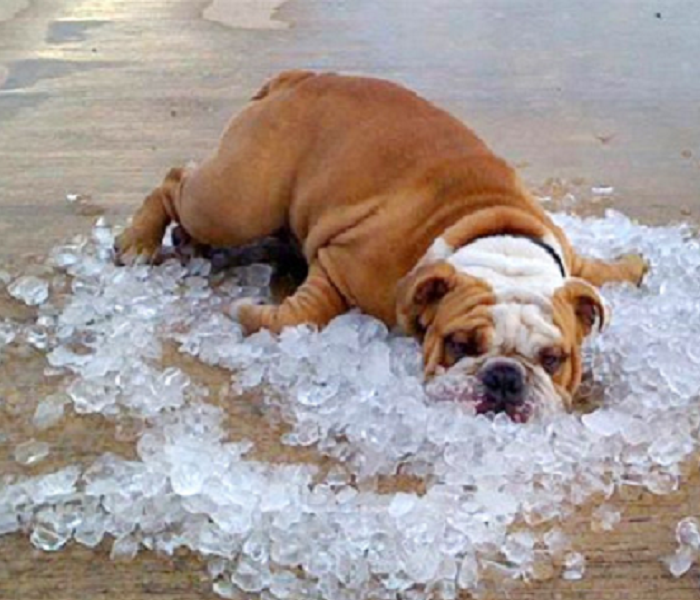 Minding the heat is everyone's responsibility.
Minding the heat is everyone's responsibility.
Tips for Preventing Heat-Related Illness (original source cdc.gov)
Wear Appropriate Clothing: Choose lightweight, light-colored, loose-fitting clothing.
Stay Cool Indoors: Stay in an air-conditioned place as much as possible. If your home does not have air conditioning, go to the shopping mall or public library—even a few hours spent in air conditioning can help your body stay cooler when you go back into the heat. Call your local health department to see if there are any heat-relief shelters in your area.
- Keep in mind: Electric fans may provide comfort, but when the temperature is in the high 90s, they will not prevent heat-related illness. Taking a cool shower or bath or moving to an air-conditioned place is a much better way to cool off. Use your stove and oven less to maintain a cooler temperature in your home.
Schedule Outdoor Activities Carefully: Try to limit your outdoor activity to when it’s coolest, like morning and evening hours. Rest often in shady areas so that your body has a chance to recover.
Pace Yourself: Cut down on exercise during the heat. If you’re not accustomed to working or exercising in a hot environment, start slowly and pick up the pace gradually. If exertion in the heat makes your heart pound and leaves you gasping for breath, STOP all activity. Get into a cool area or into the shade, and rest, especially if you become lightheaded, confused, weak, or faint.
Wear Sunscreen: Sunburn affects your body’s ability to cool down and can make you dehydrated. If you must go outdoors, protect yourself from the sun by wearing a wide-brimmed hat, sunglasses, and by putting on sunscreen of SPF 15 or higher 30 minutes prior to going out. Continue to reapply it according to the package directions.
- Tip:Look for sunscreens that say “broad spectrum” or “UVA/UVB protection” on their labels- these products work best.
Do Not Leave Children in Cars: Cars can quickly heat up to dangerous temperatures, even with a window cracked open. While anyone left in a parked car is at risk, children are especially at risk of getting a heat stroke or dying. When traveling with children, remember to do the following:
- Never leave infants, children or pets in a parked car, even if the windows are cracked open.
- To remind yourself that a child is in the car, keep a stuffed animal in the car seat. When the child is buckled in, place the stuffed animal in the front with the driver.
- When leaving your car, check to be sure everyone is out of the car. Do not overlook any children who have fallen asleep in the car.
Avoid Hot and Heavy Meals: They add heat to your body!
Stay Hydrated
Drink Plenty of Fluids: Drink more fluids, regardless of how active you are. Don’t wait until you’re thirsty to drink.
- Warning: If your doctor limits the amount you drink or has you on water pills, ask how much you should drink while the weather is hot.
- Stay away from very sugary or alcoholic drinks—these actually cause you to lose more body fluid. Also avoid very cold drinks, because they can cause stomach cramps.
Replace Salt and Minerals: Heavy sweating removes salt and minerals from the body that need to be replaced. A sports drink can replace the salt and minerals you lose in sweat.
- If you are on a low-salt diet, have diabetes, high blood pressure, or other chronic conditions, talk with your doctor before drinking a sports beverage or taking salt tablets.
Keep Your Pets Hydrated: Provide plenty of fresh water for your pets, and leave the water in a shady area.
Stay Informed
Check for Updates: Check your local news for extreme heat alerts and safety tips and to learn about any cooling shelters in your area.
Know the Signs: Learn the signs and symptoms of heat-related illnesses and how to treat them.
Use a Buddy System: When working in the heat, monitor the condition of your co-workers and have someone do the same for you. Heat-induced illness can cause a person to become confused or lose consciousness. If you are 65 years of age or older, have a friend or relative call to check on you twice a day during a heat wave. If you know someone in this age group, check on them at least twice a day.
Monitor Those at High Risk: Although anyone at any time can suffer from heat-related illness, some people are at greater risk than others:
- Infants and young children
- People 65 years of age or older
- People who are overweight
- People who overexert during work or exercise
- People who are physically ill, especially with heart disease or high blood pressure, or who take certain medications, such as for depression, insomnia, or poor circulation
Visit adults at risk at least twice a day and closely watch them for signs of heat exhaustion or heat stroke. Infants and young children, of course, need much more frequent watching.
We Answer The Phone
7/21/2020 (Permalink)
 "Guess what! We answer the phone!"
"Guess what! We answer the phone!"
Not a week goes by that we don’t get a call from a new client in desperate need of help. At the end of the phone call our office staff always asks, so how did you hear about SERVPRO? Most of the time we get an answer like my parents, neighbor, or a friend used your services in the past. Or, we looked you up on line, or saw your social media page. Not a month goes by that we don’t get a call, where the answer is, you are the only ones that answered my call. When people call us, it’s usually not because something fun and exciting happens. It’s usually on one of their worst days that they call us. When you are having a bad day, you just want someone to respond and help.
Guess what! We answer the phone! When a franchise’s office is closed for the night, the weekend, or a holiday we are still on call and answering the phone. SERVPRO headquarters has a 24 hour call center that routes all calls to the appropriate franchise. Each franchise has a dedicated person answering the phone 24 hours a day, even in the middle of the night. And finally techs are on a rotating on call schedule to make sure we can gets boots on the ground of any emergency when the calls come in.
Please follow our page, as we continue to explore the benefits of mitigation, and how this approach helps both your clients and your business. Please call us with any questions you have, 715-381-2266. Visit our site: SERVPRO of The Saint Croix Valley
Independent Franchises, But One National Team
4/21/2020 (Permalink)
 While Franchises stand alone they serve under one umbrella.
While Franchises stand alone they serve under one umbrella.
by Lance Lueck, Business Development Manager
As with anyone in sales, I get asked one question more than any other. What makes SERVPRO different then the next restoration company? It’s a great question to ask, and really struck me as I was at a vendor convention hosted by an insurance company. Sitting there at our booth I could see that the majority of vendors at this adjuster’s convention offered the same type of services we did. They all did water and fire damage restoration and mold mitigation. Some also did the same types of cleaning services we offer. Others included the mitigation and reconstruction of the structure as well. So what really does make us different?
It really starts with the fact that we are a national company, with independent owner operators. Our partners at SERVPRO Headquarters in Tennessee, set the tone for how operations are carried out. Be it from a piece of equipment that is tested and put through the ringer to make sure it will hold up in the field for our techs. Or the fact that when a disaster strikes we can quickly mobilize and send resources from around the country to help. We truly are faster to any size disaster.
None of this works though without the men and women at the franchise level. Be it the normal daytime routine, or reporting to the scene of a disaster in the middle of the night, SERVPRO techs answer the call knowing that they are walking into most people’s worst nightmare, and are the calming voice of reason and reassurance to our clients. They aren’t comic book heroes, but they do save the day on a regular basis.
Finally, we answer the phone! When a franchise’s office is closed for the night, the weekend, or a holiday we are still on call and answering the phone. SERVPRO headquarters has a 24 hour call center that routes all calls to the appropriate franchise. Each franchise has a dedicated person answering the phone 24 hours a day, even in the middle of the night. And finally, our techs are on a rotating on-call schedule to make sure we can gets boots on the ground of any emergency when the calls come in.
Please follow our page, as we continue to explore the benefits of mitigation, and how this approach helps both your clients and your business. Please call us with any questions you have, 715-381-2266 in WI, or 651-705-7028 in MN. Visit our sites: SERVPRO of The Saint Croix Valley and SERVPRO of Stillwater, Oakdale, Mahtomedi
Mold In The Attic
4/14/2020 (Permalink)
If you’re like most of us, you rarely if ever venture into your home’s attic. Why would you? It’s not usually a place you care to venture and for the most part if you do it’s because something isn’t going well. With warmer temps here for the summer, we start to see an increase in jobs where homeowners have discovered mold damage in their attic. In this blog post, we’ll talk through what we typically see when homes have considerable amounts of attic mold and help you understand ways you can make sure it doesn’t happen to you.
Why mold grows in attics
Mold damage in your attic space occurs for the same reasons it occurs anywhere else in a dwelling. It’s a combination of a few things:
() the right temperature – mold spores like warmer, ambient temps. In fact, it likes about the same temp range as we do, between 60-80 degrees Fahrenheit.
() food – no, not crumbs from discarded food a home service technicians might have left while doing some work up in your attic long ago. Mold likes anything that is high in cellulose. Unfortunately for homeowners, that’s pretty much anything in your attic, like plywood, wood joists, roof decking, etc.
() elevated moisture – many homeowners don’t realize that moisture is found in every surface of their home, as it should be. If those surfaces were completely devoid of moisture they wouldn’t perform their duties properly. But if a surface gets too much moisture in it, that’s the trigger mold needs to start growing. Another thing most homeowners don’t realize is that mold spores are present in most environments, and certainly in every home or other type of dwelling. It exists naturally and in low levels and is completely harmless to humans and pets. But with the right conditions, it can grow quickly and spread, causing wide spread damage to your home and potentially cause health effects for the home’s inhabitants.
As you can see from the list above, 2 of those things are normal. It’s the 3rd thing, elevated moisture that is not normal and creates the right environment for a mold problem. So now let’s talk through how moisture gets into attics and what you can do to make sure it doesn’t get into yours.
Causes of attic mold growth
When we are called to a home and discover mold in the attic, the culprits are usually pretty easy to spot. There are only so many ways moisture finds its way into an attic. Here’s what we usually see:
Venting directly into the attic
Many bathrooms are equipped with vents that take the warm, wet air released when a shower is running and remove it from the bathroom. Unfortunately, sometimes a misguided homeowner or shoddy handyman will simply install the vent fan such that the air is pushed into the attic where it has nowhere to escape. Bathroom fans should be vented to the outside of the house. If you have an older home that is equipped with one or multiple of these types of exhaust fans, it’s probably worth you taking a look in the attic space to make sure it’s vented properly.
A leaky roof
One culprit we find when inspecting an attic with mold is a leaky roof. Just one damaged or misplaced shingle can allow rain water to slowly seep into your attic. While most people picture a deluge of water coming through their ceiling, more often than not, a roof leak will just allow a slow amount of rain water to enter the attic, usually soaking the roof deck and eventually dripping down onto the attic floor and/or your exterior walls. We recommend that you (safely) inspect your roof’s exterior each spring and it’s also a good idea to just crawl up into your attic and peer at the interior decking of the roof. If you start to see staining, it’s a sign you have some moisture intrusion that needs to be addressed!
Improper Ventilation
Your attic needs to breathe. When we have extended periods of extremely cold weather like we had this past winter, warm air leaks from the interior of your home into the attic. This warm wet air will condensate on the roof deck and possibly ice over the ventilation. One it warms up, this frost will thaw causing the roof deck to get wet. One sign to look for is roofing nails that are rusty. We recommend working with an insulating contractor to make sure your attic vents well so you can avoid this problem.
With a few simple steps and things to be mindful of your attic can remain trouble free. If you suspect you have a problem feel free to give us a call. 715-381-2266
Independent Franchises, But One National Team
3/28/2020 (Permalink)
As with anyone in sales, I get asked one question more than any other. What’s makes SERVPRO different then the next restoration company? It’s a great question to ask, and really struck me as I was at a vendor convention hosted by an insurance company. Sitting there at our booth I could see that the majority of vendors at this adjusters convention offered the same type of services we did. They all did water and fire damage restoration and mold mitigation. Some also did the same types of cleaning services we offer. Others included the mitigation and reconstruction of the structure as well. So what really does make us different?
It really starts with the fact that we are a national company, with independent owner operators. Our partners at SERVPRO Headquarters in Tennessee, set the tone for how operations are carried out. Be it from a piece of equipment that is tested and put through the ringer to make sure it will hold up in the field for our techs. Or the fact that when a disaster strikes we can quickly mobilize and send resources from around the country to help. We truly are faster to any size disaster.
None of this works though without the men and women at the franchise level. Be it the normal daytime routine, or reporting to the scene of a disaster in the middle of the night, SERVPRO techs answer the call knowing that they are walking into most people’s worst nightmare, and are the calming voice of reason and reassurance to our clients. They aren’t comic book heroes, but they do save the day on a regular basis.
Finally, we answer the phone! When a franchise’s office is closed for the night, the weekend, or a holiday we are still on call and answering the phone. SERVPRO headquarters has a 24 hour call center that routes all calls to the appropriate franchise. Each franchise has a dedicated person answering the phone 24 hours a day, even in the middle of the night. And finally techs are on a rotating on call schedule to make sure we can gets boots on the ground of any emergency when the calls come in.
Please follow our page, as we continue to explore the benefits of mitigation, and how this approach helps both your clients and your business. Please call us with any questions you have, 715-381-2266. Visit our site: SERVPRO of The Saint Croix Valley
SERVPRO is Here to Help during this time of need
3/20/2020 (Permalink)
During this unprecedented time caused by the global pandemic of corona virus, this is a reminder to our customers that we are specialists in cleaning services, and we adhere to the highest cleaning and sanitation standards.
Specialized Training
We are prepared to clean and disinfect your home or business, according to protocols set forth by the Centers for Disease Control and Prevention. We have years of experience in dealing with biological contaminants, and we will go beyond the scope of work that regular janitorial staff perform on a daily basis.
The CDC encourages cleaning of high-touch surfaces such as counters, tabletops, doorknobs, light switches, bathroom fixtures, toilets, phones, keyboards, tablets and tables. Other spaces mentioned in the CDC’s guidance for commercial spaces include:
- Kitchen/Food Areas
- Bathrooms
- Schools/Classrooms
- Offices
- Retail Spaces
- Water Fountains
- Shelving/Racks
- Sales Counters
- Carpets and Rugs
- Stair Handrails
- Elevator Cars
- Playground Equipment
- Fitness Equipment
Specialized Products
The CDC recommends usage of a labeled hospital-grade disinfectant with claims against similar pathogens to the corona virus. Multiple products in the SERVPRO product line carry the EPA-approved emerging pathogens claims. While there is currently no product tested against this particular strain of the corona virus, we are following all guidelines as provided by the CDC and local authorities.
Please follow our page, as we continue to explore the benefits of mitigation, and how this approach helps both your clients and your business. Please call us with any questions you have, 715-381-2266.
6 Steps to a Professional Kitchen Hood Cleaning
9/25/2019 (Permalink)
Regular cleanings of restaurant kitchen hood vents are an essential part of any fire safety maintenance plan. Without regular attention, oil and other debris can build up in the hood, exhaust fan, filters and ductwork, significantly increasing the chances of a grease fire. Undergoing a hood cleaning twice a year will help you meet the National Fire Protection Agency’s (NFPA) standards for reducing the risk of fire. This process typically takes between three and six hours. To help you prepare for your upcoming appointment, here’s a guide to what to expect during this procedure.
What Happens During a Professional Hood Cleaning?
- Kitchen Prep
Hood cleaning may create a mess, so the cleaning company will begin by prepping the kitchen for the process. This includes turning off pilot lights and gas valves, covering appliances, and removing any items that could potentially get contaminated by the cleaning chemicals and dirty water. The cleaning crew will also remove all filters and disassemble any wall-mounted hoods and fans for cleaning.
- Filter Cleaning
Kitchen exhaust filters often become caked in grease and grime. The hood cleaning process involves removing the filters and soaking them in a cleaning solution to loosen the hardened grease. After several hours, the filters are power-washed and then reinstalled.
- Fan Cleaning
Kitchen exhaust fans are another place where grease builds up. Fire safety maintenance requires the fans to be removed for a thorough cleaning from top to bottom to reduce hidden hazards. The crew will spray the fan with degreasing chemicals and then scrub the blades clean by hand and power washing. Before the fans are reinstalled, the entire system is inspected and the fan belts replaced to ensure it’s in working order.
- Vent & Ductwork Inspection
NFPA guidelines require that all exhaust duct systems be cleaned and degreased regularly, so a thorough hood cleaning includes manually scraping any solidified grease from the vents and ducts before spraying on chemicals to dissolve the remaining grease. After a final scrub, the vents and ductwork are inspected to ensure they comply with NFPA rules.
- Power Washing
Once the fans, vents, and filters are clean, the crew will tackle the kitchen hoods themselves. This begins with manually scraping congealed grease from the hood, and then applying a degreasing cleaning chemical to loosen any remaining residue. After 30 to 60 minutes, the cleaners power-wash the hood with hot water, leaving it clean and free of grease that could start a fire.
- Inspection & Documentation
The final step of the process happens once the crew has restored the kitchen to its prior condition. This is when the process will be documented and your technician will apply a certification sticker to the unit. This tells health inspectors and insurance companies that you are in compliance NFPA guidelines and have worked with licensed fire protection services to ensure the safety of your kitchen.
If your restaurant kitchen hood needs cleaning, call SERVPRO of The Saint Croix Valley at 715-381-2266. Our trained professionals can help many of your professional cleaning and mitigation needs.
Facts About Mold
9/11/2019 (Permalink)
For more than a decade, mold has been in the news. People are talking about the effect on population health and damage to the building. But what are the risks and issues?
The available science on molds and their potential health effects remains under study, but considerable progress has been made. The U.S. Centers for Disease Control and Prevention (CDC), the Institute of Medicine of the U.S. National Academy of Sciences, the World Health Organization and Health Canada all agree that living or working in a building with mold damage results in increased risk of respiratory disease. Although there are several guidance documents available, there are no accepted national or international standards for mold investigation, evaluation or remediation. AIHA, however, has worked to translate the advice from the previously mentioned government agencies into state-of-the-art inspection and sampling protocols, such as AIHA’s Recogni?tion, Evaluation and Control of Indoor Mold? book, also known as the Green Book. If properly used, these methods are suitable for assessing hidden contamination and directing essential visual inspections. For health outcomes, there are no available exposure assessment methods that can provide useful information for individuals. This is primarily due to the fact that each person’s response to mold exposure is unique.
The scientific complexities surrounding this issue would be a huge challenge but the truth is that other, less scientific, difficulties dwarf them. Media attention on this topic often creates emotionally charged circumstances, making scientific and professional judgment, as well as reasoned dialogue on this subject, very difficult. In some instances, building owners have been known to ignore or dismiss potentially serious problems. Many indoor air quality (IAQ) problems have nothing to do with mold, and buildings seldom have only one indoor environmental quality problem. It is essential to consider multiple sources of building IAQ problems instead of focusing on just mold concerns. In other instances, building occupants or public officials armed with mold sampling reports of dubious quality have reacted with alarm to potential threats, making risk communication very difficult.
Public and occupational health practice is rarely an exact science. Prevention always poses the challenge of making tough and often costly decisions with incomplete information or understanding.
The Facts about Mold: For Everyone
What is mold?
The term “mold” is a colloquial term for a group of filamentous fungi that are common on food or wet materials. This includes the green Penicillium species that produces penicillin, and fungi that spoil our bread, fruit, cheese and crops. Most of these are Ascomycetes that produce a lot of spores.
The majority of the molds that grow on damp building materials are found in the soil and are adapted to grow on a wide variety of materials. Outdoors, molds live in the soil, on plants, and on dead or decaying matter. There are thousands of species of mold and they can be any color. Different mold species are adapted to different moisture conditions ranging from very wet to just damp. Many times, mold can be detected by a musty odor. Live spores act like seeds, forming new mold growths (colonies) under the right conditions. All of us are exposed to a variety of fungal spores daily in the air we breathe, both outdoors and indoors.
How mold gets into a house or building
Mold and fungal spores occur naturally outdoors, where fungi are the earth’s most important recyclers. Indoors, mold needs moisture to grow; it becomes a problem only where there is water damage, elevated and prolonged humidity, or dampness. Common sources of excessive indoor moisture that can lead to mold problems include:
- flooding from surface waters (i.e., overflowing rivers) or from severe storms;
- roof leaks from damaged or missing roofing materials, ice dams or blocked gutters;
- storm-driven rain through window frames, exterior walls or door assemblies;
- leaking pipes, sewer back-ups or overflows;
- damp basements or crawl spaces due to a high-water table or poorly managed rainwater drainage; and
- condensation on cold surfaces.
How to prevent mold growth
The key to preventing and stopping indoor mold growth is to control excessive moisture and condensation. Keeping susceptible areas in the home clean and dry is critical. In general, mold will not grow indoors without water, dampness or excessive moisture.
Three main factors contribute to condensation of water on building surfaces:
- Relative Humidity: Condensation occurs when the air is saturated with water and it cannot hold any more moisture. For example, steam generated from bathroom showers or from cooking can fill up the air with moisture, which will then condense into drops of water on cooler surfaces, such as mirrors and windows. Where possible, localized sources of humidity, such as clothes dryers, should be directly vented to the outdoors. To lower indoor humidity during warm, humid weather, air conditioners and/or dehumidifiers should be used. In chronically damp areas such as basements or crawlspaces, it is often recommended that dehumidifiers be used to maintain humidity levels below 60 percent.
- Temperature: Warm air holds more moisture than cold air. Condensation occurs when warm humid air comes into contact with a cold surface and the moisture condenses into water. This can often be seen on single-pane windows, where water condenses and then runs down, causing the wood frames and sills to rot and the wall under the windows to blister. Condensation can occur on exterior walls, particularly north-facing walls, if they are not properly insulated. Other chronically cold surfaces, such as cold-water pipes, should be covered with insulation to help prevent condensation.
- Poor Ventilation: Indoor humidity can build up if there is not enough ventilation and exchange of indoor and outdoor air. Where there is little or no air movement, such as behind dressers and cabinets, surfaces can remain cooler than surrounding areas, which can lead to increased condensation and mold growth. It is recommended that the area be ventilated and the occupants use exhaust fans (vented to the outdoors) to remove moisture from high-humidity areas, particularly in bathrooms, kitchens and laundry areas. Furniture should be moved slightly away from walls so that air can freely pass behind it. Air should be allowed to circulate between rooms and regularly ventilate to remove humid air. Fans should be used as needed.
Other things that can be done are to clean and repair gutters regularly, make sure the ground slopes down and away from the home’s foundation and keep air conditioner drip pans and drain lines clean. In addition, in air-conditioned buildings in hot and humid climates, vinyl wall coverings on the interior sides of exterior walls should not be used, as these materials can trap moisture, resulting in mold growth underneath them.
In the case of floods or leaking pipes, any standing water should be promptly removed and water-damaged materials should either be dried out and cleaned, or removed and replaced. Porous materials that are wet for more than 48 hours are likely to produce mold growth and should be discarded. In instances where the water damage is extensive, it is recommended that professional help, such as a commercial restoration company, be consulted.
If you have had mold growth from these conditions please call us at SERVPRO of the Saint Croix Valley 715-781-2266. Our professionals, combine with industry standard technology and experience can help mediate needs quickly and professionally.
Restore vs. Replace
7/26/2019 (Permalink)
SERVPRO of The Saint Croix Valley specializes in restoring contents damaged by water, fire, or mold. Our expertise and “restore” versus “replace” mentality can help you save money while preserving precious keepsakes that can’t be replaced. We pretest your belongings to determine what items we can restore to pre-fire condition. We use several methods of cleaning your contents, including:
- Dry Cleaning - Used for cleaning light residues or to pre-clean prior to wet cleaning.
- Wet Cleaning - An effective cleaning method for removing moderate to heavy residues.
- Spray and Wipe -Effective for items that can’t withstand wet cleaning.
- Foam Cleaning - Used for upholstery fabrics that might shrink or bleed if wet cleaned.
- Abrasive Cleaning - Involves agitation of the surface being cleaned.
- Immersion Cleaning - Contents are dipped into a bath of the cleaning product.
Move-Outs/Pack-Outs
If your home requires extensive restoration or cleaning due to fire damage, SERVPRO of The Saint Croix Valley can conduct an organized, efficient move-out of the affected area. Move-out will provide several benefits, including:
- A quicker remodeling processes
- Protecting items from potential damage
- Protecting contents from further on-site damage
When restoration is completed, we will work with you to coordinate the move-in according to your needs. The services offered upon move-in may depend on your insurance coverage.
Electronic Cleanup
Fire-damaged electronics can present a serious hazard. Do not attempt to turn on or operate any electrical device that you suspect has been damaged by fire. Smoke residues can contain acids that corrode metal surfaces. If the residues are not removed, corrosion causes electronic failure in the device. We will coordinate the restoration of your electronics, including:
- Television sets
- DVD players
- Computers
- And more
The key to restoring electronics is taking prompt action to prevent further damage. Electronics will be cleaned and inspected by a qualified electronics technician.
Document / Photograph Drying
When your valuable documents, including photographs, are damaged by water or fire, extreme caution should be taken to help ensure the fire damage does not destroy the document. Although some documents may not be restored to pre-fire damage condition, SERVPRO of The Saint Croix Valley can save a great deal and help minimize additional damage.
Depending on the type of documents and the level of fire, smoke, or soot damage, they have five options for the restoration of documents:
- Air Drying
- Dehumidification
- Freezer Drying
- Vacuum Freeze Drying
- Vacuum Thermal Drying
Contents Claim Inventory Service
When a fire emergency strikes, the damage can often feel overwhelming. We can help ease the worry and confusion during the recovery process by offering our Contents Tracker by Xactware, which provides a detailed and accurate list of your belongings. We take a room-by-room inventory of your contents, including digital photos, and in some instances, bar coding.
Our Contents Claim Inventory Service:
- Pre-loss list and value of contents
- Detailed and accurate report
- Better information to settle claims quicker
- Assistance with burden of proof for claims
Peace of mind when you need it most!






 24/7 Emergency Service
24/7 Emergency Service



















